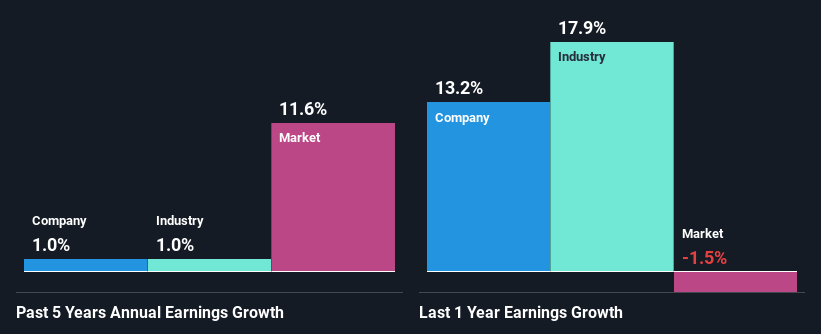
Severfield (LON:SFR) has had a rough week with its share price down 3.8%. However, the company’s fundamentals look pretty decent, and long-term financials are usually aligned with future market price movements. In this article, we decided to focus on Severfield’s ROE.
Return on equity or ROE is a key measure used to assess how efficiently a company’s management is utilizing the company’s capital. In short, ROE shows the profit each dollar generates with respect to its shareholder investments.
Check out our latest analysis for Severfield
How Do You Calculate Return On Equity?
The formula for ROE is:
Return on Equity = Net Profit (from continuing operations) ÷ Shareholders’ Equity
So, based on the above formula, the ROE for Severfield is:
9.8% = UK£21m ÷ UK£218m (Based on the trailing twelve months to September 2023).
The ‘return’ is the amount earned after tax over the last twelve months. One way to conceptualize this is that for each £1 of shareholders’ capital it has, the company made £0.10 in profit.
What Has ROE Got To Do With Earnings Growth?
We have already established that ROE serves as an efficient profit-generating gauge for a company’s future earnings. We now need to evaluate how much profit the company reinvests or “retains” for future growth which then gives us an idea about the growth potential of the company. Generally speaking, other things being equal, firms with a high return on equity and profit retention, have a higher growth rate than firms that don’t share these attributes.
A Side By Side comparison of Severfield’s Earnings Growth And 9.8% ROE
To start with, Severfield’s ROE looks acceptable. Yet, the fact that the company’s ROE is lower than the industry average of 12% does temper our expectations. On further research, we found that Severfield’s earnings over the past five years have been pretty flat. Bear in mind, the company does have a respectable level of ROE. It is just that the industry ROE is higher. So there might be other reasons for the flat earnings growth. For example, it could be that the company has a high payout ratio or the business has alloacted capital, for instance.
We then performed a comparison between Severfield’s net income growth with the industry, which revealed that the company’s growth is similar to the average industry growth of 1.0% in the same 5-year period.
The basis for attaching value to a company is, to a great extent, tied to its earnings growth. It’s important for an investor to know whether the market has priced in the company’s expected earnings growth (or decline). This then helps them determine if the stock is placed for a bright or bleak future. If you’re wondering about Severfield’s’s valuation, check out this gauge of its price-to-earnings ratio, as compared to its industry.
Is Severfield Making Efficient Use Of Its Profits?
Severfield has a high three-year median payout ratio of 52% (or a retention ratio of 48%), meaning that the company is paying most of its profits as dividends to its shareholders. This does go some way in explaining why there’s been no growth in its earnings.
In addition, Severfield has been paying dividends over a period of eight years suggesting that keeping up dividend payments is way more important to the management even if it comes at the cost of business growth. Based on the latest analysts’ estimates, we found that the company’s future payout ratio over the next three years is expected to hold steady at 42%.
Summary
On the whole, we do feel that Severfield has some positive attributes. Its earnings have grown respectably as we saw earlier, which was likely achieved by the company reinvesting its earnings at a decent rate of return. Still, its earnings retention is quite low, so we wonder if the company’s growth could be higher, were it to pay out less dividends and retain more of its profits? Having said that, looking at the current analyst estimates, we found that the company’s earnings are expected to gain momentum. To know more about the company’s future earnings growth forecasts take a look at this free report on analyst forecasts for the company to find out more.
Have feedback on this article? Concerned about the content? Get in touch with us directly. Alternatively, email editorial-team (at) simplywallst.com.
This article by Simply Wall St is general in nature. We provide commentary based on historical data and analyst forecasts only using an unbiased methodology and our articles are not intended to be financial advice. It does not constitute a recommendation to buy or sell any stock, and does not take account of your objectives, or your financial situation. We aim to bring you long-term focused analysis driven by fundamental data. Note that our analysis may not factor in the latest price-sensitive company announcements or qualitative material. Simply Wall St has no position in any stocks mentioned.

